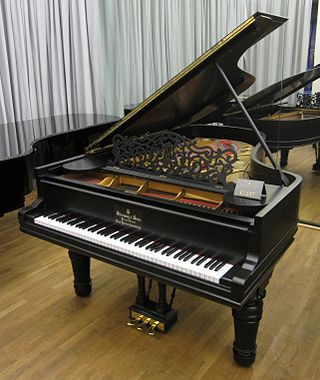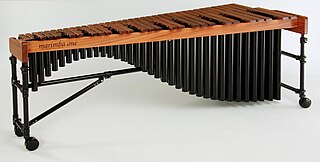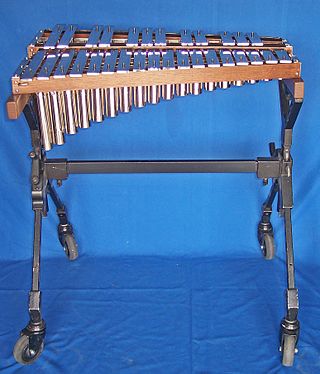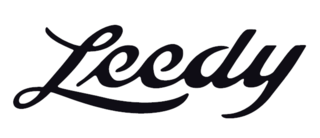
The piano is a keyboard instrument that produces sound when its keys are depressed, through engagement of an action whose hammers strike strings. Modern pianos have a row of 88 black and white keys, tuned to a chromatic scale in equal temperament. A musician who specializes in piano is called a pianist.

The marimba is a musical instrument in the percussion family that consists of wooden bars that are struck by mallets. Below each bar is a resonator pipe that amplifies particular harmonics of its sound. Compared to the xylophone, the marimba has a lower range. Typically, the bars of a marimba are arranged chromatically, like the keys of a piano. The marimba is a type of idiophone.

The vibraphone is a percussion instrument in the metallophone family. It consists of tuned metal bars and is typically played by using mallets to strike the bars. A person who plays the vibraphone is called a vibraphonist,vibraharpist, or vibist.

The glockenspiel or bells is a percussion instrument consisting of pitched aluminum or steel bars arranged in a keyboard layout. This makes the glockenspiel a type of metallophone, similar to the vibraphone.

An electric piano is a musical instrument that has a piano-style musical keyboard, where sound is produced by means of mechanical hammers striking metal strings or reeds or wire tines, which leads to vibrations which are then converted into electrical signals by pickups. The pickups are connected to an instrument amplifier and loudspeaker to reinforce the sound sufficiently for the performer and audience to hear. Unlike a synthesizer, the electric piano is not an electronic instrument. Instead, it is an electro-mechanical instrument. Some early electric pianos used lengths of wire to produce the tone, like a traditional piano. Smaller electric pianos used short slivers of steel to produce the tone. The earliest electric pianos were invented in the late 1920s; the 1929 Neo-Bechstein electric grand piano was among the first. Probably the earliest stringless model was Lloyd Loar's Vivi-Tone Clavier. A few other noteworthy producers of electric pianos include Baldwin Piano and Organ Company, and the Wurlitzer Company.

Yamaha Corporation is a Japanese musical instrument and audio equipment manufacturer.
Piano construction is by now a rather conservative area; most of the technological advances were made by about 1900, and indeed it is possible that some contemporary piano buyers might actually be suspicious of pianos that are made differently from the older kind. Yet piano manufacturers, especially the smaller ones, are still experimenting with ways to build better pianos.

Aliquot stringing is the use of extra, un-struck strings in a piano for the purpose of enriching the tone. Aliquot systems use an additional string in each note of the top three piano octaves. This string is positioned slightly above the other three strings so that it is not struck by the hammer. Whenever the hammer strikes the three conventional strings, the aliquot string vibrates sympathetically. Aliquot stringing broadens the vibrational energy throughout the instrument, and creates an unusually complex and colorful tone.

Julius Blüthner Pianofortefabrik GmbH is a piano-manufacturing company in Leipzig, Germany. Composers who used Blüthner include Brahms, Debussy, Wagner, Strauss, Tchaikovsky, Rachmaninoff, and the Beatles among others.
Reynolds Group Holdings was a New Zealand–based packaging company with roots in the former Reynolds Metals Company, which was the second-largest aluminum company in the United States, and the third-largest in the world. Reynolds Metals was acquired by Alcoa in June 2000. Reynolds Group Holdings became Pactiv Evergreen through an IPO in 2020.
C. G. Conn Ltd., Conn Instruments or commonly just Conn, is a former American manufacturer of musical instruments incorporated in 1915. It bought the production facilities owned by Charles Gerard Conn, a major figure in early manufacture of brasswinds and saxophones in the USA. Its early business was based primarily on brass instruments, which were manufactured in Elkhart, Indiana. During the 1950s the bulk of its sales revenue shifted to electric organs. In 1969 the company was sold in bankruptcy to the Crowell-Collier-MacMillan publishing company. Conn was divested of its Elkhart production facilities in 1970, leaving remaining production in satellite facilities and contractor sources.

A resonator guitar or resophonic guitar is an acoustic guitar that produces sound by conducting string vibrations through the bridge to one or more spun metal cones (resonators), instead of to the guitar's sounding board (top). Resonator guitars were originally designed to be louder than regular acoustic guitars, which were overwhelmed by horns and percussion instruments in dance orchestras. They became prized for their distinctive tone, and found life with bluegrass music and the blues well after electric amplification solved the problem of inadequate volume.

Guitar manufacturing is the use of machines, tools, and labor in the production of electric and acoustic guitars. This phrase may be in reference to handcrafting guitars using traditional methods or assembly line production in large quantities using modern methods. Guitar manufacturing can also be broken into several categories such as body manufacturing and neck manufacturing, among others. Guitar manufacturing includes the production of alto, classical, tenor, and bass tuned guitars.
Clair Omar Musser (1901–1998) was a marimba virtuoso, a conductor and promoter of marimba orchestras, a composer, a teacher, a designer of keyboard percussion instruments, an inventor, and an engineer for Hughes Aircraft.

Song bells are a musical instrument in the keyboard percussion family. They are a mallet percussion instrument in the metallophone family that is essentially a cross between the vibraphone, glockenspiel, and celesta. They have bars made of aluminum.

J. C. Deagan, Inc. is a former musical instrument manufacturing company that developed and produced instruments from the late 19th- to mid-20th century. It was founded in 1880 by John Calhoun Deagan and initially manufactured glockenspiels. It was noted for its development of the xylophone, vibraharp, organ chimes, aluminum chimes, aluminum harp, Swiss handbells, the marimba, orchestra bells, and marimbaphone.
Howmet Aerospace Inc. is an American aerospace company based in Pittsburgh, Pennsylvania. The company manufactures components for jet engines, fasteners, titanium structures for aerospace applications, and forged aluminum wheels for heavy trucks.

The Leedy Manufacturing Company was an American manufacturer of percussion instruments headquartered in Indianapolis, Indiana. Leedy was highly successful in the early twentieth century, and was at one point the largest manufacturer of drums and other percussion instruments in the world.













